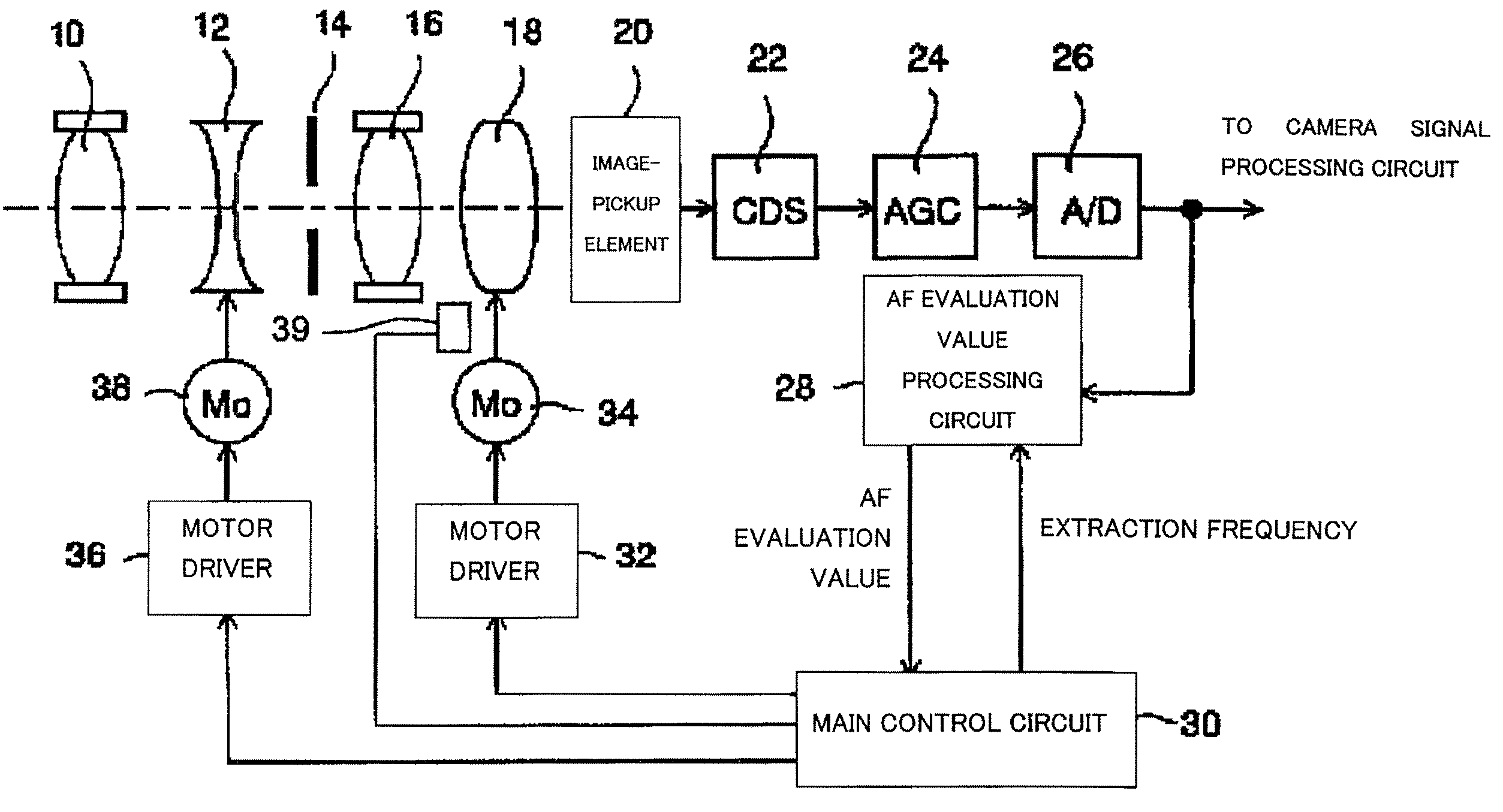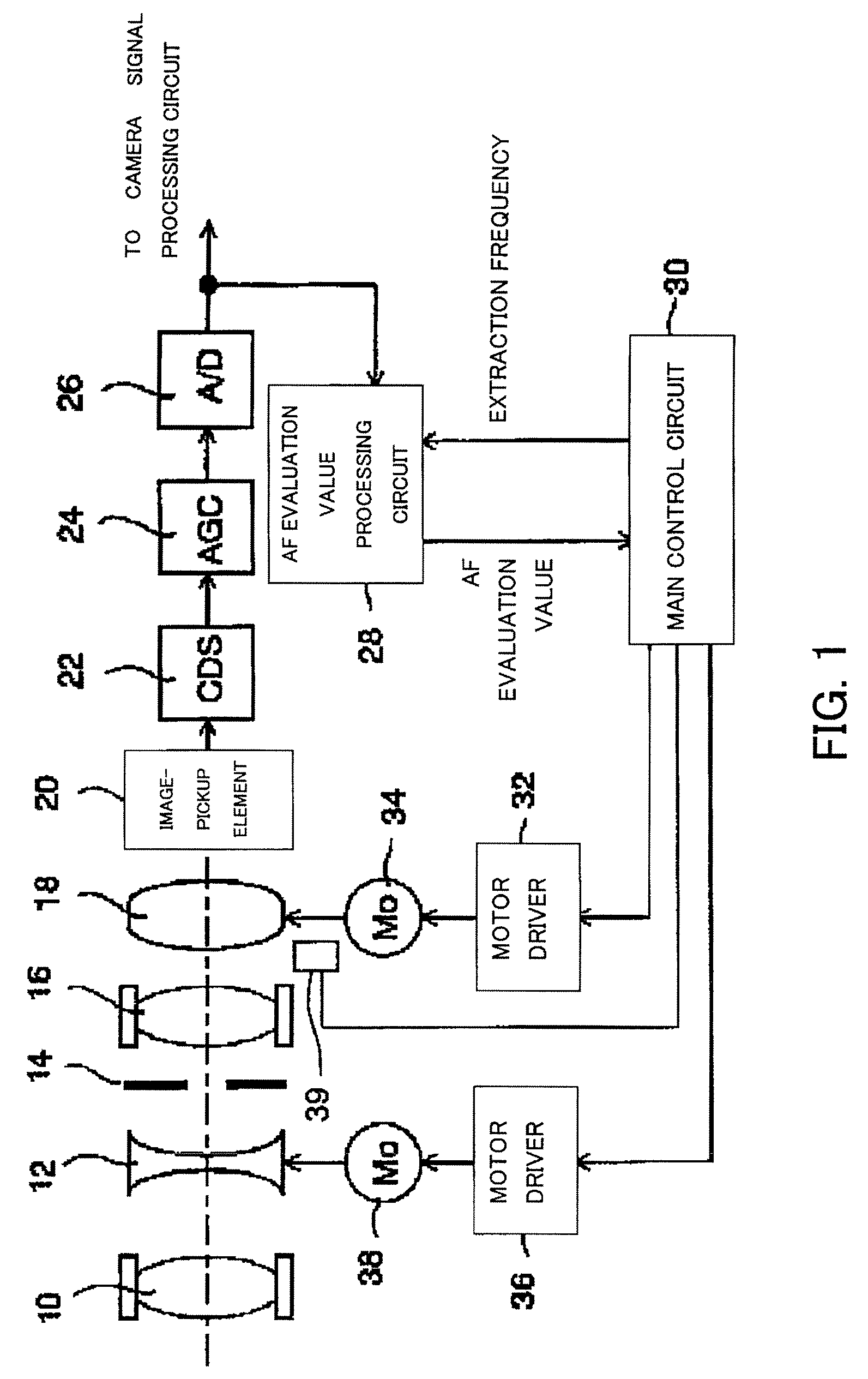Optical apparatus
a technology of optical equipment and optical sensors, applied in the field of optical equipment, can solve the problems of inability to achieve focus, inability to achieve satisfactory in-focus accuracy, and favorable af performance, and achieve the effect of favorable af control and high in-focus accuracy
- Summary
- Abstract
- Description
- Claims
- Application Information
AI Technical Summary
Benefits of technology
Problems solved by technology
Method used
Image
Examples
embodiment 1
[0040]In Embodiment 1, an AF evaluation value signal in a high frequency band as a high-definition frequency band and an AF evaluation value signal in a low frequency band as an NTSC frequency band are synthesized (added) to provide a synthesis AF evaluation value signal for use in AF control. However, the synthesis which accentuates the characteristic of the AF evaluation value signal in the high frequency band is not always performed during AF control but is performed after a focusing operation to near an in-focus point using the AF evaluation value signal in the low frequency band, thereby achieving focusing with higher accuracy.
[0041]First, the general outlines of Embodiment 1 will be described with reference to FIGS. 12A to 12D, 13A to 13D, and 10A. As described above, FIGS. 12A and 13A show the examples in which the person as the major subject is at the center of the frame, the mountain and trees are behind the person as the background, respectively, and the object is in front...
embodiment 2
[0184]Embodiment 2 of the present invention will hereinafter be described. The basic structure of an image-pickup apparatus in Embodiment 2 is identical to the structure described with reference to FIG. 1 in Embodiment 1. Components identical to those in Embodiment 1 are designated with the same reference numerals as those in FIG. 1.
[0185]In Embodiment 2, the in-focus determination is made using the first synthesis AF evaluation value signal in the first step of minute-drive control, and then, in the second step, final in-focus determination is made using the second synthesis AF evaluation value signal. Each in-focus determination is performed on the basis of a repeat of to-and-fro movement of the focus lens 18 a predetermined number of times in the same area.
[0186]In other words, coarse in-focus determination is first made (in a wide allowable area) by confirming a repeat of to-and-fro movement a predetermined number of times using the first synthesis AF evaluation value signal con...
embodiment 3
[0211]Embodiment 3 of the present invention will hereinafter be described. FIG. 9 shows the structure of an image-pickup apparatus serving as an optical apparatus of Embodiment 3. The image-pickup apparatus is realized by a video camera or a digital still camera which are integral with a lens and its image-pickup system can be switched between the standard TV system and the high-definition system. Moving images or still images may be picked up by the apparatus. Components of the camera identical to those in Embodiment 1 are designated with the same reference numerals as those in Embodiment 1 and the description thereof is omitted.
[0212]In FIG. 9, reference numeral 40 shows an image-pickup system selecting switch for allowing an operator to select image pickup in the standard TV system such as NTSC and PAL or image pickup in the high-definition system. In other words, the switch 40 is provided for setting the resolution of images to be picked up. When the switch 40 is used to select ...
PUM
 Login to View More
Login to View More Abstract
Description
Claims
Application Information
 Login to View More
Login to View More - R&D
- Intellectual Property
- Life Sciences
- Materials
- Tech Scout
- Unparalleled Data Quality
- Higher Quality Content
- 60% Fewer Hallucinations
Browse by: Latest US Patents, China's latest patents, Technical Efficacy Thesaurus, Application Domain, Technology Topic, Popular Technical Reports.
© 2025 PatSnap. All rights reserved.Legal|Privacy policy|Modern Slavery Act Transparency Statement|Sitemap|About US| Contact US: help@patsnap.com



